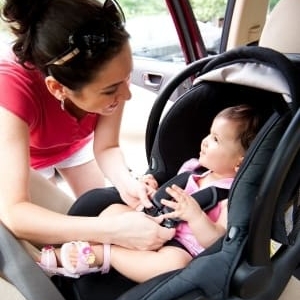Infant abductions are still possible in today’s world of electronic security nets in most hospitals. Although the numbers of actual abductions from within hospitals are down in the last ten years, attempts still take place, as do actual abductions.


- Female of “childbearing” age (range now 12 to 53), often overweight.
- Most likely compulsive; most often relies on manipulation, lying, and deception.
- Frequently indicates she has lost a baby or is incapable of having one.
- Often married or cohabitating; companion’s desire for a child or the abductor’s desire to provide her companion with “his” child may be the motivation for the abduction.
- Usually lives in the community where the abduction takes place.
- Frequently visits nursery and maternity units at more than one healthcare facility prior to the abduction; asks detailed questions about procedures and the maternity floor layout; frequently uses a fire-exit stairwell for her escape; and may also try to abduct from the home setting.
- Usually plans the abduction, but does not necessarily target a specific infant; frequently seizes any opportunity present.
- Frequently impersonates a nurse or other allied healthcare personnel.
- Often becomes familiar with healthcare staff members, staff members work routines, and victim parents.
- Demonstrates a capability to provide “good” care to the baby once the abduction occurs.
An Abductor Who Abducts from the Home Setting
- Is more likely to be single while claiming to have a partner.
- Often targets a mother whom she may find by visiting healthcare facilities and trying to meet the target family.
- Often both plan the abduction and bring a weapon, although the weapon may not be used.
- Often impersonates a healthcare or social-services professional when visiting the home.
There is no guarantee an infant abductor will fit this description.
How Does This Still Happen With Security Technology In Place?
An Abductor Who Abducts from the Home Setting Is more likely to be single while claiming to have a partner. Often targets a mother whom she may find by visiting healthcare facilities and trying to meet the target family. Often both plan the abduction and bring a weapon, although the weapon may not be used. Often impersonates a healthcare or social-services professional when visiting the home. There is no guarantee an infant abductor will fit this description.
How Does This Still Happen With Security Technology In Place?
Hospitals have come a long way in improving security measures over the years, as
well as by training staff to watch for warning indicators that there may be a problem. However, not all hospitals have updated their equipment, tested their systems regularly, or trained their staff.
Security systems are being improved almost annually in the healthcare market, yet some hospitals do not update their systems due to the costs, and there are even some hospitals still with no electronic security systems in place today. In most cases, it is either no budget to make the improvements, or lack of security awareness on the part of security or administration.
Best Practices in Infant Security
Infant Security System Testing Should Be Completed at Least Monthly
We know of some hospitals that have had their systems off-line for well over 30 days without knowing it, because they never tested it. Preventive maintenance should be routine, and always documented. If a system is found to be not working, or has vulnerabilities in some areas, an action plan must be developed, and other security measures should be put into place to reduce and manage the risks associated with a non-functioning system.
Regular Infant Security Training Should Be Conducted
All employees and medical staff that work on the labor and delivery, postpartum, and the pediatrics units should have security training for their units, and know how to respond to any security issues with the infants/toddlers. The training should include topics such as
- Parental custody
- Social Services taking custody of an infant
- Security policies
- And much more
Training should happen at least annually and be documented with some type of competency evaluation method to test the employees knowledge.
Do Not Publish a Birth Announcement
By doing so, you are placing your child at risk for abduction after the baby leaves the hospital. It used to be very common for such announcements, and it used to be common for yard signs to be put up to announce the new arrival; however, when parents do things like this, they are increasing their personal security risks and those of their infant.
Hospitals often times will ask parents to sign a release of liability for the hospital if you insist on a newspaper announcement. Hospitals know the dangers that you are self-imposing by publishing a birth announcement, and they do not want to be not liable for your decision. Several hospitals do not even offer this service anymore, and for good reason.
Security Outside the Hospital
Once you take your new baby home, your risk of abduction will go up. You no longer have the safety net that most hospitals have in place once you leave, so now it is up to you to keep your child safe and secure.


Safety & Security Tips for New Parents
- Do not allow anyone into your home that you do not know.
- If someone shows up at your home and says that they are from the hospital, call the hospital and verify it before you let them in.
- Just because someone is wearing hospital scrubs does not insure that they are affiliated with the hospital. Ask to see their ID badges.
- Never leave your infant unattended in public, not even for a second.
- It is not safe to put up yard signs announcing your new infant’s arrival. It just tells others that have bad motives that you have an infant inside.
- Hospitals should not encourage you to publish a notice in the newspaper about your infant’s birth. It has been proven that that notice will compromise your infant’s security. Most hospitals do not offer it anymore, but if you insist they will help you after you sign a release of liability, so that you cannot come back and sue them if something happens to your infant. (That release should be a warning to you.)
- If a stranger takes a strong interest in your infant, or all the sudden wants to be your friend and/or baby sit, please contact your local police. Try to give the police information that you know is factual, like their license plate number or phone number. Remember, the name that the person gives you may or may not be their real name.
- If something does not feel right to you, and you feel that you are not safe, contact your police department right away.
More infants are abducted after they leave the hospital than from within hospitals. Hospital security for the most part has electronic systems in place to protect their infant patients, as well as strict security controls and trained staff, but most homes have little or no security. It is up to the parents to form a protective bubble around their infants at home and while in public.


